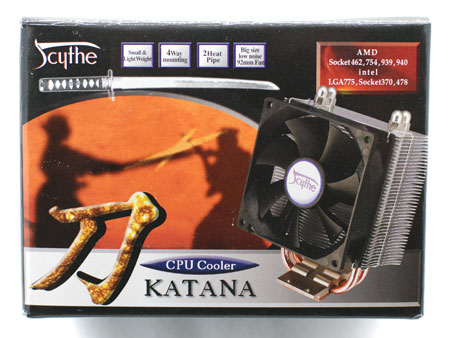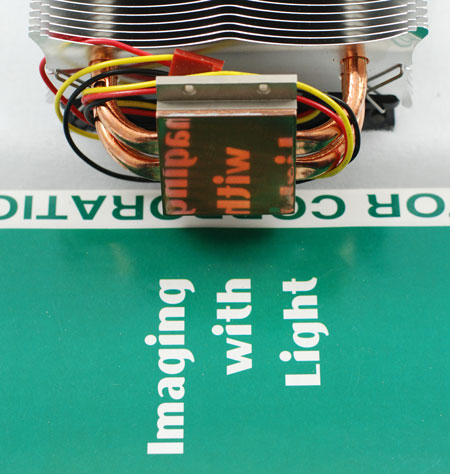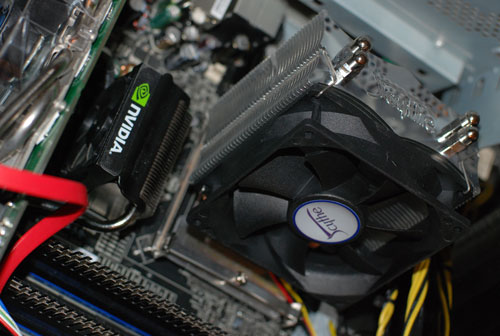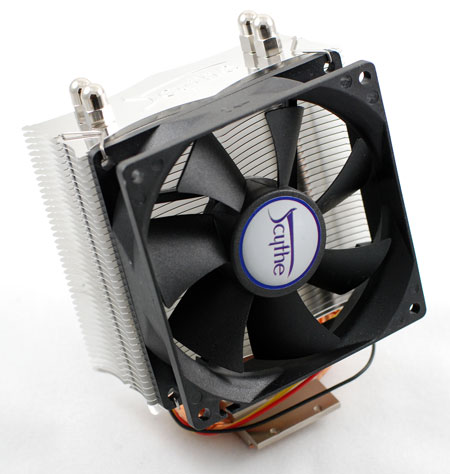Value Cooling: Two Towers for under $30
by Wesley Fink on January 23, 2007 3:50 AM EST- Posted in
- Cases/Cooling/PSUs
Scythe Katana
Scythe produces a wide range of air cooling solutions for the computer enthusiast. There are currently about a dozen air cooling solutions detailed on the company website. These range from entry level cooling solutions all the way to powerful cooling tower designs.
Scythe Co., Ltd is a Japanese company located in Tokyo. Beginning in 2002 Scythe started manufacturing and distributing products for the PC enthusiast, including CPU cooling solutions. Scythe's first product, the Scythe Samurai, developed quite a reputation among computer enthusiasts. Their current catalog includes the well-known full cooling tower solution, the Scythe Infinity.

Scythe likes using full color graphics and Japanese fight themes in their packaging. The Katana is no exception.

While the Thermalright MST-9775 is designed to support just the Socket 775, the Katana includes an incredible array of hardware to adapt it to AMD Socket A (462), 754/939/940, Intel 370, Intel 478, and Intel 775. It should also be mentioned that Katana is one of the few current coolers that actually meets AMD's recommendation of 300g maximum weight for Socket A coolers.

The mounting surface of Katana is highly polished. Many do not believe this matters much on processors with integral heatspreaders like Core 2 Duo, P4, Socket 478 and AM2. However, a smooth mating surface does matter a great deal on small surface area processors like Athlon XP and other Socket A designs.
With Katana supporting so many different sockets, it should be no surprise that some installations are easier than others. Installation on Socket A is a breeze, but Socket 775 installation is a nightmare. The motherboard has to be removed from the case to install the back plate and adapters which basically make 775 into a Socket 478 cage. Then you have to install flat "clips" with a set screw to create the pressure to hold the cooler in place - all while holding the cooler.

The point is the installation is possible, but we could find no way to do it in a case. Install the cooler before remounting the motherboard. The finished Core 2 Duo install took a while, but once it is done properly, the cooler works just fine on a Core 2 Duo processor.

Scythe also suggests that the Katana be mounted so the fan, which blows through the fins/heatpipes, is aimed toward a rear exhaust. This works well in cases with a top-mounted power supply. In designs with the power supply at the bottom of the case a top exhaust should also work fine.
The Scythe Katana uses a large 92mm fan that runs at just one speed - 2000rpm. There are no provisions for variable fan speed, but you can add a fan controller like the Zalman if you want. There is also an upgraded Katana model - the Katana CU - which adds all copper construction and a fan controller to the base Katana for about $15 more (total $40).
Scythe produces a wide range of air cooling solutions for the computer enthusiast. There are currently about a dozen air cooling solutions detailed on the company website. These range from entry level cooling solutions all the way to powerful cooling tower designs.
Scythe Co., Ltd is a Japanese company located in Tokyo. Beginning in 2002 Scythe started manufacturing and distributing products for the PC enthusiast, including CPU cooling solutions. Scythe's first product, the Scythe Samurai, developed quite a reputation among computer enthusiasts. Their current catalog includes the well-known full cooling tower solution, the Scythe Infinity.

Scythe likes using full color graphics and Japanese fight themes in their packaging. The Katana is no exception.

While the Thermalright MST-9775 is designed to support just the Socket 775, the Katana includes an incredible array of hardware to adapt it to AMD Socket A (462), 754/939/940, Intel 370, Intel 478, and Intel 775. It should also be mentioned that Katana is one of the few current coolers that actually meets AMD's recommendation of 300g maximum weight for Socket A coolers.

The mounting surface of Katana is highly polished. Many do not believe this matters much on processors with integral heatspreaders like Core 2 Duo, P4, Socket 478 and AM2. However, a smooth mating surface does matter a great deal on small surface area processors like Athlon XP and other Socket A designs.
With Katana supporting so many different sockets, it should be no surprise that some installations are easier than others. Installation on Socket A is a breeze, but Socket 775 installation is a nightmare. The motherboard has to be removed from the case to install the back plate and adapters which basically make 775 into a Socket 478 cage. Then you have to install flat "clips" with a set screw to create the pressure to hold the cooler in place - all while holding the cooler.

The point is the installation is possible, but we could find no way to do it in a case. Install the cooler before remounting the motherboard. The finished Core 2 Duo install took a while, but once it is done properly, the cooler works just fine on a Core 2 Duo processor.

Scythe also suggests that the Katana be mounted so the fan, which blows through the fins/heatpipes, is aimed toward a rear exhaust. This works well in cases with a top-mounted power supply. In designs with the power supply at the bottom of the case a top exhaust should also work fine.
The Scythe Katana uses a large 92mm fan that runs at just one speed - 2000rpm. There are no provisions for variable fan speed, but you can add a fan controller like the Zalman if you want. There is also an upgraded Katana model - the Katana CU - which adds all copper construction and a fan controller to the base Katana for about $15 more (total $40).










28 Comments
View All Comments
takumsawsherman - Wednesday, January 24, 2007 - link
Why is the Tuniq tower 120 being compared against much cheaper coolers with smaller fans? Why not pit it against the Thermalright HR-01, which would be more of an apples to apples comparison?I am sure that Scythe must have a more worthy competitor as well, though I am not familiar with their line.
LoneWolf15 - Thursday, January 25, 2007 - link
Scythe's Infinity is probably the closest competitor. I believe there may be a few other sites that have reviewed it.
Wesley Fink - Wednesday, January 24, 2007 - link
You neglected to mention that we also compared the performance of the Scythe Katana and Thermalright MST-9775 to the Intel Retail HSF that comes with the Core 2 Duo processor. Until we test a cooler that might perform better than the Tuniq the range of performance is "real-world" between the Intel Retail HSF and the Tuniq. We believe most readers want to know how a tested cooler compares in this rnage - so they can decide if the features or cost are worth the performance drop from the best we have tested.In the future we will be testing some new tower coolers that should challenge the Tuniq. We also plan a value cooler roundup of coolers under $30.
Zoomer - Wednesday, January 24, 2007 - link
Seconded!I'm looking forward to seeing the Arctic Cooler 7 Pro review. In cooler climates with a core2 duo, there is really no need to spend the extra $30 for a huge tower heatsink.
Calin - Wednesday, January 24, 2007 - link
The comparison was between the baseline (the included cooler) and the best air cooler there is (at least known/proven until now).Should the Tuniq Tower be compared to the best air cooled equipments out there? Yes, and it would be nice to compare it to a not very expensive water cooled system too.
Jodiuh - Wednesday, January 24, 2007 - link
Well if that's not reason enough to get a Tuniq.LoneWolf15 - Wednesday, January 24, 2007 - link
Getting one dropped my temps from my old Swiftech by 5-8C when idle and 8-15C under load.It sure was a good enough reason for me. And that's with the fan at a quiet 1400rpm.
And I agree (with what I think you're saying) that, if you're going to spend $30 for an aftermarket cooler, and the Tuniq will fit, why not spend an extra 20-25 for best aftermarket cooler you can get?
Avalon - Tuesday, January 23, 2007 - link
I think it's a good addition to AT to include cooling reviews. However, you guys should see if you can expand temperature gauging a little more to also include PWM temps and other important temperatures, as some HSF solutions have a large affect on these, while others don't.Also, really want to see the Coolermaster Hyper TX in the next roundup!
Vidmar - Tuesday, January 23, 2007 - link
What was the orientation of the CPU/heatsink during the tests? Was the case (and MB) in a horizontal or vertical orientation? Since these new coolers use heatpipes and since the heatpipe technology relies on a liquid that turns to gas when heated then back to liquid when cool, the orientation of the heatsink/heatpipe plays a huge role in how the well it will perform.I would like to think that you are running these tests with the case in a vertical orientation like what a large portion of your readers would be using. But since you never say we don’t know. If these tests are being conducted with the case in a horizontal orientation (laying flat on a table), I would expect that the results would be different than what people would get at home (mostly vertical).
Thanks!
Wesley Fink - Tuesday, January 23, 2007 - link
Noise measurements were run with the case horizontal and an open side. Cooling tests were run with the case in the standard upright position, as our readers will most likely use them at home.